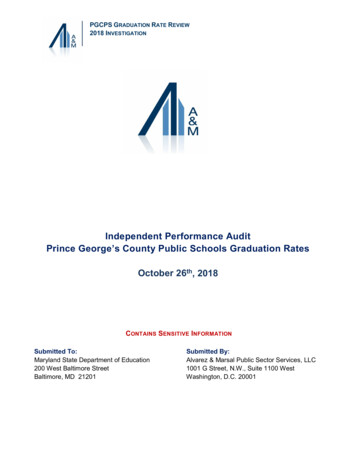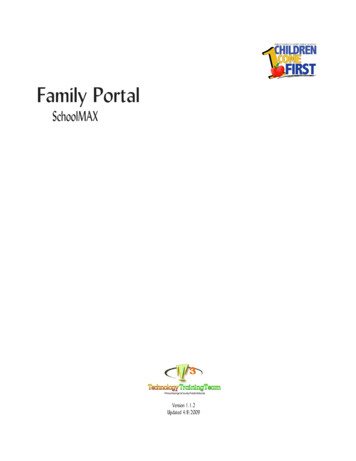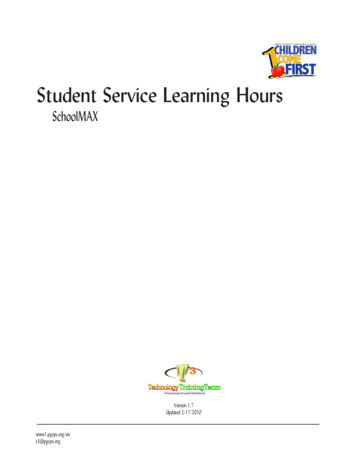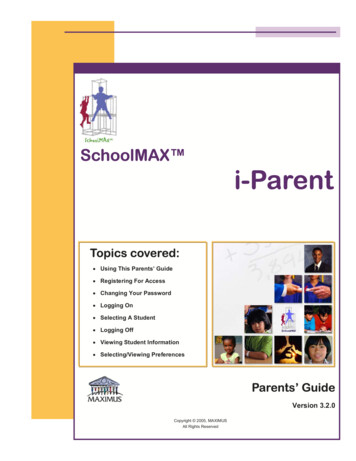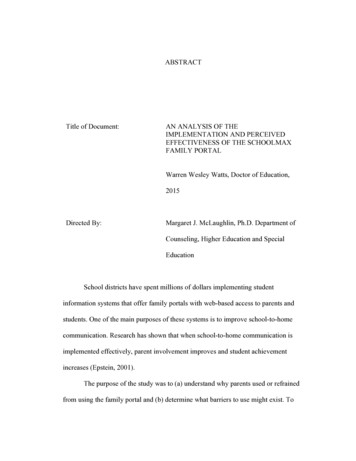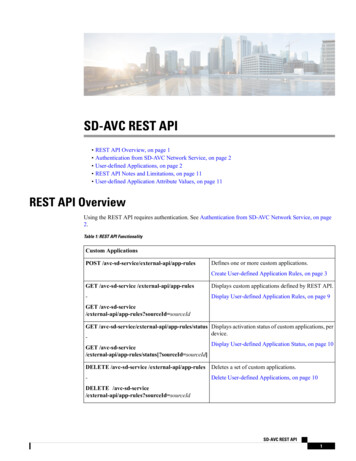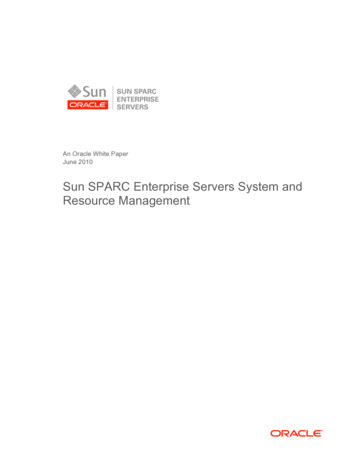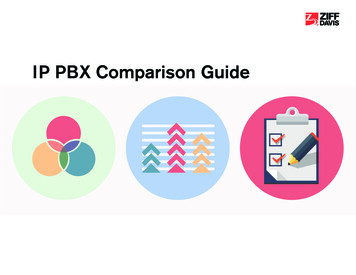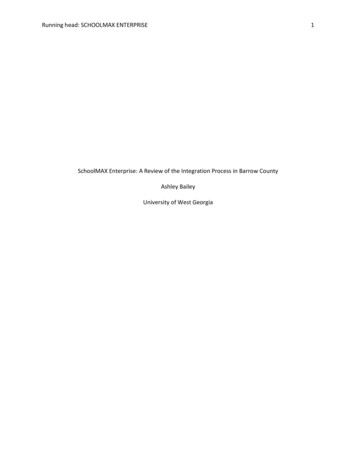
Transcription
Running head: SCHOOLMAX ENTERPRISE1SchoolMAX Enterprise: A Review of the Integration Process in Barrow CountyAshley BaileyUniversity of West Georgia
2SCHOOLMAX ENTERPRISESettingThe Barrow County School (BCS) system is located about half way between Athens and Atlanta,Georgia. BCS is a system of fifteen schools, eight elementary, four middle, and two high schools. BCS hasaround 12,000 students with an economically disadvantage population of about 47%. All schools inBarrow County, with the exception of one elementary school, fall under Title 1 status. Until the 20082009 school year, Barrow County used several different data programs to keep school records, bothacademic and administrative. They used programs including I-Cue, Munis, and Crystal. Each of theseprograms kept up with a different aspect of the student information system. These programs were alsoserver-based, meaning that the program was loaded on to each computer and could only be accessed atschool or by someone on the Barrow County Schools network.Barrow County Schools recently purchased an upgrade of the previous SchoolMAX software inplace to track discipline and bookkeeping items. SchoolMAX went web-based in 2006 and the countyoffice purchased this upgrade option in 2007. In addition to features for accounting and recordkeeping,the upgrade was supposed to integrate our Student Information System with our attendance andgrading program so that all information would be in one location. I was a member of a committee ofteachers was formed in late spring of 2008 to “test” the program an awesome program. The programthat we were shown was a very user friendly program. It was web-based rather than server-based andso it required more “clicks” than the previous program used by the teachers and was accessible at homeor at school. Based on this one demonstration of the program, the county office decided to utilize theprogram the next school year. The integration process was complicated by obstacles that teachers andadministrators were not equipped to handle, making the successful implementation almost impossible.Innovation IntegrationSchoolMAX was the county’s first program that compiled these aspects into one program. Asgood as this sounds, it was not a pleasant transition. As part of the implementation of the program
3SCHOOLMAX ENTERPRISEsome teachers were given a two- hour tutorial and then were required to redeliver to coworkers toprepare them for the beginning of school. This was done during pre-planning of the 2008-2009 schoolyear.Open House night was the Thursday before school started the following Monday. Studentscome to the school and get their class schedule and can visit their soon to be teachers. On the day ofopen house, the SchoolMAX server crashed and all of the schedules were gone. We had to hand writearound 750 schedules based on what few schedules we had printed out. It was a nightmare culminatingwith having to give students and parents hand written schedules that would probably have to berescheduled the following week.The school year began with teachers getting very little training and very little communicationbetween the county office and each school regarding this new program. No one at the individual schoolshad been adequately trained. The county ITS department decided to start a Student InformationSystems (SIS) committee. Principals from each middle and high school selected a representative fromtheir teachers, registrars, and guidance counselors to serve on this committee. The committee began tomeet to bring lists of problems each school was having with SchoolMAX to the county’s attention. Thelists were then combined, prioritized and discussed by the committee. The SIS Committee meets every2-4 weeks in order to stay on top of problems with the program.At one point, the problems with SchoolMAX had gotten so bad that the county looked intotrying to get out of the contract with Harris Computers, the company that bought out SchoolMAX in thefall of 2008. It was impossible for the county to get out of the contract, however, the inquiry into leavingHarris Computers at the end of the contract prompted the leaders of the company to pay moreattention to all the problems the county was having. Barrow County was one of five systems in Georgiathat had signed on with the new integrated system and all were having difficulties. Harris Computers
4SCHOOLMAX ENTERPRISEsent a team of software, hardware and other experts to come to our county and see firsthand thestruggles the county was having due to the new program.Currently the county and the SIS Committee are working together with Harris Computers to fixthe parts of the program that are not user friendly or do not work. It has been a long road since thepurchase of this program but I think we are finally seeing the light at the end of the tunnel in regards tocomplete diffusion of this innovation.The AnalysisAs a member of the SIS Committee, I am not aware of how the system came to purchase thisupgrade. If hind sight is 20/20, the county may see that the use of one of the diffusion models fromSurviving Change (2000) may have been useful to make the diffusion smooth.Ely’s Conditions of Change model allows implementation of new innovations to require theenvironment to be taken into consideration. Ely has specified eight “ground rules” that must occur forinnovation implementation to be successful (Ellsworth, 2000). Let’s examine the implementation ofSchoolMAX based on these eight principles.According to Ely, there must be “dissatisfaction with the status quo” in order for change to occur(Ellsworth, 2000, p. 68). Was the county not satisfied with their current system? Were there majorproblems? As a teacher, I did not feel that there was anything wrong with the previous program. At thispoint, I would have not recommended change because I was not dissatisfied and the product we hadserved us well.Once the dissatisfaction has been declared, Ely’s next rule must be met. “The people who willultimately implement any innovation must possess sufficient knowledge and skills to do the job”(Ellsworth, 2000, p. 68), meaning that the teachers and staff members that are actually working with theinnovation need to know how it works. In the instance of SchoolMAX, teachers were not properlytrained. This lack of training let our teachers to inadvertently hinder the diffusion process
5SCHOOLMAX ENTERPRISEEly’s next rule is “The things that are needed to make the innovation work should be easilyaccessible” (Ellsworth, 2000, p. 69). Barrow County economically disadvantaged student population iscurrently at 47% and is growing every day. The county does not receive a ton of money from SPLOST orproperty taxes because of this number. Therefore, our technology is somewhat outdated. Can thisprogram run on an older machine? A lot of new software must have the latest and greatest in order towork appropriately. Our system does not me meet this requirement for effective implementation ofSchoolMAX.“Implementers must have time to learn, adapt, integrate, and reflect on what they are doing”(Ellsworth, 2000, p. 69) If a new technology or innovation is introduced to a school’s staff, propertraining and continued training must be implemented. With this grading program, it was given to us andwe were expected to use with little or no training. Many teachers got frustrated very quickly and gaveup on the program. This led to dissatisfaction by a large population of the system employees.“Rewards or incentives [must] exist for participants” (Ellsworth, 2000, p. 70). This goes back to“dissatisfaction of the status quo” (Ellsworth, 2000, p. 68). If there is a strategy or innovation in yourschool that is working, but there is something better coming down the line, the teachers that you expectto embrace and implement the change need to be rewarded for their extra work. Learning a newprogram takes extra time out of the teacher’s schedule and this should be noted by principals andcounty leaders. Rewards and incentives will create a better atmosphere for teacher “buy-in”.“Participation {in the change process must be} expected and encouraged” (Ellsworth, 2000, p.71). Administrators need to make sure the implemented practice is being utilized by the teachers in theclassroom. They must have a positive attitude toward the innovation and expect the same of theteachers. This also goes along with the quality and ease of the program. SchoolMAX is not the most userfriendly program. There needed to be extra emphasis put on getting to know the program before theyare expected to use it in a regular setting.
6SCHOOLMAX ENTERPRISEThe next step in Ely’s model involves the process of diffusion in itself. “An unqualified go-aheadand vocal support for the innovation by key players and stakeholders is necessary” (Ellsworth, 2000, p.71). A person should feel involved in the process if they are expected to use the new innovation. If youjust tell someone that they are going to do something, they are less likely to be on boardwholeheartedly. In the instance with SchoolMAX, I feel that the support for this program was notavailable at the beginning. I think that if more people were brought on board at an earlier time, then theissues that were faced would not have been so substantial.The final rule of Ely’s model is “Leadership {must be} evident” (Ellsworth, 2000, p. 72). Ifleadership (individual or otherwise) is not evident, there won’t be success of integration or innovation.The lack of leadership in the implementation of the new SchoolMAX software was very apparent.Although many people would say the implementation was not successful, I would have to disagree. Yes,it was very difficult in the beginning and yes, we failed according to Ely’s model. However, we are stillusing the program so it is not a complete loss.Ely’s model for diffusion of innovations shows that Barrow County needs to think about howthey implement new technologies into the school system. The model showed that the necessary itemswere not in place for the innovation to be a success. We will still be using SchoolMAX because offinancial limitations, but going forward, I will look to these innovations with a more critical eye.
7SCHOOLMAX ENTERPRISEResourcesEllsworth, J. (2000). Surviving change: a survey of educational change models. Washington, DC: Office ofEducational Research and Improvement.(2008). SchoolMAX Enterprise. Retrieved from http://www.schoolmax.net/Stansbury, M. (2009, August 31). SchoolMAX cited in back-to-school nightmare PGCPS administratorsblame software glitches and poor planning for scheduling breakdown that leaves parents andstudents furious. E School News, Retrieved from http://www.eschoolnews.com/news/topnews/?i 60424
SchoolMAX was the county's first program that compiled these aspects into one program. As good as this sounds, it was not a pleasant transition. As part of the implementation of the program . 3 SCHOOLMAX ENTERPRISE some teachers were given a two- hour tutorial and then were required to redeliver to coworkers to
